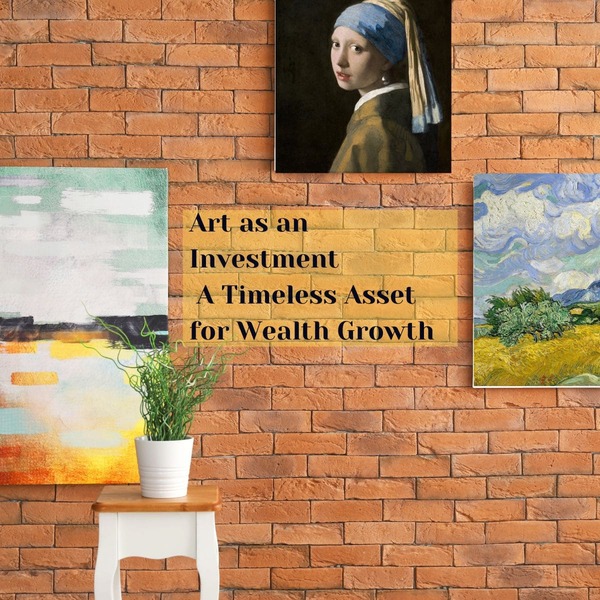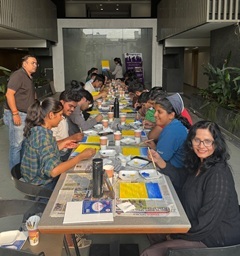

Art is a deeply personal yet universal experience that holds different meanings for people. For some, it serves as a powerful form of expression, allowing them to convey emotions, ideas, and stories that transcend words. Others see art as a source of inspiration, drawing creativity and beauty from the diverse forms it takes—whether visual, auditory, or performative. It is also a reflection of culture and history, capturing the essence of a time or society and providing insight into shared human experiences. Art connects people, creating a space for interpretation, discussion, and community. For many, it is a tool for self-discovery and healing, offering a therapeutic outlet for exploring identity or coping with emotions. Ultimately, art is a profound way of communicating and connecting with the world around us.
We’ll explore the reasons why art can be a valuable asset, how it compares to traditional investments and tips for getting started in the art market.
Art brings a wide range of experiences and benefits to people, both on a personal and collective level. It offers:
.
1. Long-Term Value Appreciation
One of the most compelling reasons to invest in art is its potential for long-term value appreciation. Over time, works by established and even emerging artists can increase in value, sometimes exponentially. The art market is driven by supply and demand—original works of art are one-of-a-kind, and as an artist’s reputation grows, so too does the value of their work.
For example, many investors who purchased works by contemporary artists like Jean-Michel Basquiat or Yayoi Kusama early in their careers have seen their pieces multiply in value over time. Unlike some traditional investments, art’s intrinsic value is tied to culture and history, which often enhances its worth over the years.
2. Portfolio Diversification
Art provides an excellent way to diversify your investment portfolio. While stocks and bonds are susceptible to market volatility, the art market tends to behave independently of traditional financial markets. This makes art a relatively stable investment, especially during times of economic uncertainty or market crashes.
In addition to this, art is considered a tangible asset, like gold or real estate, offering you a physical item of intrinsic value. By investing in art, you can hedge against risks in other asset classes and spread your investments across different types of assets.
3. Emotional and Aesthetic Value
One of the unique aspects of investing in art is the emotional and aesthetic value it brings to your life. While other investments may only exist as numbers on a screen, a piece of art can be hung on your wall, admired, and appreciated daily. Investing in art allows you to combine the joy of ownership with the potential for financial gain.
In essence, art is more than just an investment—it’s a cultural and personal asset. Collecting art can also provide emotional satisfaction, offering a deep connection to artists, history, and creativity.
4. Legacy and Philanthropy
Art can also serve as a legacy for future generations. Unlike financial stocks or properties, art often has sentimental value, which can be passed down through families. In some cases, art collectors donate their collections to museums or foundations, creating a legacy that contributes to cultural heritage while providing tax benefits.
Many investors also view art as a philanthropic opportunity. Supporting emerging artists through purchases can help bolster their careers, contributing to the growth of the art world while making a wise investment
Like any investment, art comes with risks and challenges that potential investors should consider.
Art is generally considered a long-term investment, partly because it lacks liquidity compared to stocks or bonds. Selling a piece of art can take time, as it requires finding a buyer, often through galleries or auctions. The sale of high-value art pieces may take even longer, making it difficult to liquidate quickly in case of an emergency.
Investing in art requires a deep understanding of the art world, trends, and artists. Prices can fluctuate based on an artist’s reputation, the condition of the piece, and market demand. Without proper knowledge or guidance, there’s a risk of overpaying for a piece or investing in works that may not appreciate significantly over time.
Verifying the authenticity and provenance (ownership history) of an artwork is crucial to its value. Buyers must ensure they are purchasing genuine pieces, especially in the secondary market, where forgeries or misrepresented works can reduce the investment’s value.
If you’re interested in art as an investment, here are some tips to get started:
Research the Market
Begin by researching artists, art movements, and current market trends. Familiarize yourself with key factors that drive an artwork’s value, such as the artist’s career trajectory, previous auction records, and current popularity.
Consult Experts
Working with art advisors, galleries, or auction houses can help you navigate the art market. These experts can offer insight into emerging artists, guide you in building a collection, and help authenticate pieces before purchase.
Start Small
You don’t need to buy million-dollar masterpieces to begin investing in art. Start by collecting smaller, affordable works by emerging artists or prints and limited editions by more established names. As your knowledge and confidence grow, you can expand your collection into more valuable pieces.
Visit Art Fairs and Exhibitions
Attending art fairs, exhibitions, and galleries is a great way to discover new talent and get a sense of pricing and trends. Many art fairs, such as Art Basel and Frieze, feature a wide range of galleries and artworks, providing a comprehensive overview of the art market.
Consider Online Art Platforms
Online platforms like Artsy, Saatchi Art, and other art marketplaces offer access to a broad range of artworks, from contemporary to classical. These platforms make art investing more accessible, offering transparency in pricing and provenance.
Art offers a unique opportunity for investors to diversify their portfolios, support culture, and enjoy the aesthetic and emotional rewards of ownership. While it comes with risks such as liquidity challenges and market knowledge requirements, art’s potential for long-term appreciation and its timeless value make it an attractive option for those looking to invest in more than just financial returns.
Whether you’re new to the art market or a seasoned collector, investing in art can be a fulfilling journey that blends passion with financial growth. By starting small, researching thoroughly, and consulting experts, you can build a collection that not only enhances your life but grows in value over time.
Join Thigma Today
Whether you’re an artist eager to share your creations with the world or a collector in search of your next acquisition, Thigma is the ultimate destination for buying and selling art online. Join our vibrant community today and experience the future of the art market.
Sign up now and start your journey with Thigma!
If you know any artists or you are one feel free to contact us.

Create, Connect, Collaborate!
